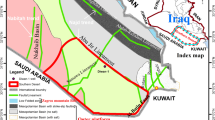Abstract
A football stadium with a capacity of a hundred thousand spectators is under construction over a karst terrain, 10 km west of the old town of Istanbul, Turkey. A large cavity of approximately 30 m3 was detected beneath the sports field through a number of boreholes so that a geophysical survey was required to further investigate a portion of the sports field. We utilized seismic refraction tomography and dc-electrical method with rotated Wenner array to delineate zones with solution voids and cavities. Total core recovery (TCR) was 5–15% from boreholes where zones with low velocities were identified through tomographic inversion, whereas TCR values were above 60% in zones with higher velocities. Both low velocity zones in the tomographic images and increasing resistivity anisotropy with depth appear to indicate that the cavity extends toward the west and south at a depth of approximately 8 m, although the southward and westward extension changes in character.






Similar content being viewed by others
References
Benson RC, Yuhr L (1993) Spatial sampling considerations and their applications to characterizing fractured rock and karst systems. In: Beck BF (ed) Applied karst geology. AA Balkema, Rotterdam, pp 99–113
Carpenter PJ, Calkin SF, Kaufmann RS (1991) Assessing a fractured landfill cover using electrical resistivity and seismic refraction techniques. Geophysics 56(11):1896–1904
Carpenter PJ, Doll WE, Kaufmann RD (1998) Geophysical character of buried sinkholes on the Oak Ridge Reservation, Tennessee. J Environ Eng Geophys 3:133–145
Gautam P, Pant SR, Ando H (2000) Mapping of subsurface karst structure with gamma ray and electrical resistivity profiles: a case study from Pokhara Valley, central Nepal. J Appl Geophys 45:97–110
Guerin R, Benderitter Y (1995) Shallow karst exploration using MT-VLF and DC resistivity methods. Geophys Prospect 43:635–653
Karaman A, Carpenter PJ (1997) Fracture density estimates in glaciogenic deposits from P-wave velocity reductions. Geophys 62(1):138–148
Kaufmann O, Quinif Y (1997) Cover collapse sinkholes in the “Tournaisis” area, southern Belgium. In: Beck BF, Stephenson JB, Herring JG (eds) The engineering geology and hydrogeology of karst terranes. AA Balkema, Rotterdam, pp 41–47
Kesseru Z (1997) Assessing the risk of cave-collapse sinkholes using analogous information from mining. In: Beck BF, Stephenson JB, Herring JG (eds) The engineering geology and hydrogeology of karst terranes. AA Balkema, Rotterdam, pp 55–60
Knott DL, Newman FB, Gonzalez LFR, Gray RE (1993) Foundation engineering practice for bridges in karst areas. In: Beck BF (ed) Applied karst geology. AA Balkema, Rotterdam, pp 224–230
Lambert DW (1997) Dipole–dipole D.C. resistivity surveying for exploration of karst features. In: Beck BF, Stephenson JB, Herring JG (eds) The engineering geology and hydrogeology of karst terranes. AA Balkema, Rotterdam, pp 413–418
McDowell P, Hope V (1993) The location and delineation of karst and solution collapse features by acoustic tomography. In: Beck BF (ed) Applied karst geology. AA Balkema, Rotterdam, pp 123–129
Mylroie JE, Carew JL (1997) Land use and carbonate island karst. In: Beck BF, Stephenson JB, Herring JG (eds) The engineering geology and hydrogeology of karst terranes. AA Balkema, Rotterdam, pp 3–12
Paukstys B, Cooper AH, Arustiene J (1997) Planning for gypsum geohazards in Lithuania and England. In: Beck BF, Stephenson JB, Herring JG (eds) The engineering geology and hydrogeology of karst terranes. AA Balkema, Rotterdam, pp 3–12
Tharp TM (1997) Mechanics of formation of cover-collapse sinkholes. In: Beck BF, Stephenson JB, Herring JG (eds) The engineering geology and hydrogeology of karst terranes. AA Balkema, Rotterdam, pp 29–36
Yaoru L, Cooper AH (1997) Gypsum karst geohazards in China. In: Beck BF, Stephenson JB, Herring JG (eds) The engineering geology and hydrogeology of karst terranes. AA Balkema, Rotterdam, pp 117–126
Acknowledgments
This project was carried out for the main contractor Istanbul Stadium Builders J.V. The complete geotechnical work was carried out by Zemin Teknolojisi A.Ş. (ZETAŞ) under the directorate of Turan Durgunoğlu who has requested the implementation of this project. We would like to thank Kadem Ekşi for providing the resources of EMA Geophysics for the measurements. As time was scarce because the entire construction operations were to be ceased for the geophysical measurements, Mehmet Abidin, Mehmet Baş, Mehmet Kocaman, Mehmet Güler, Nevzat Mengüllüoğlu, Selçuk Karaman, Burak A. Tunalı, and Şakir Şahin, all from EMA Geophysics, worked diligently for a day and a night to ensure the top quality seismic and resistivity data. We also would like to thank to the site engineers of ZETAŞ, especially Serdar Elgun, for carefully supervising the drillings and for providing us with reliable borehole data, and Gülçin Tezel for her field assistance. The principle author is a consulting geophysicist for EMA Geophysics through an agreement 01-03-001 with ITU.
Author information
Authors and Affiliations
Corresponding author
Rights and permissions
About this article
Cite this article
Karaman, A., Karadayılar, T. Identification of karst features using seismic P-wave tomography and resistivity anisotropy measurements. Env Geol 45, 957–962 (2004). https://doi.org/10.1007/s00254-003-0953-4
Received:
Accepted:
Published:
Issue Date:
DOI: https://doi.org/10.1007/s00254-003-0953-4




